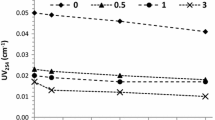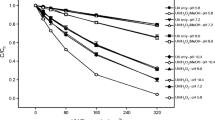Abstract
Halobenzoquinones (HBQs) are highly toxic disinfection byproducts (DBPs) and are also precursors of other DBPs such as trihalomethanes (THMs). The formation of THMs from HBQs during chlorine-only and UV/chlorine processes with or without bromide was investigated experimentally. Density functional theory (DFT) reactivity descriptors were also applied to predict the nucleophilic/electrophilic reactive sites on HBQs and intermediates. The results were combined to explain the different behaviors of 2,6-dichloro-1,4-benzoquinone (2,6-DCBQ) and tetrachloro-1,4-benzoquinone (TCBQ) and to propose mechanism for the promoting roles of UV and hydroxylation of HBQs in THMs formation. Under UV/chlorine, UV significantly enhanced THMs formation from 2,6-DCBQ compared to chlorine-only, mainly due to the production of OH-DCBQ*. Excited 2,6-DCBQ* by UV benefited nucleophilic hydrolysis to produce OH-DCBQ*, which favored electrophilic attack by chlorine, thereby inducing more THMs formation. UV/chlorine modestly promoted THMs formation from TCBQ compared to chlorine-only. Hydroxylation of TCBQ and UV irradiation were both important in promoting THMs formation due to the high electrophilic property of OH-TCBQ and TCBQ*. Meanwhile, hydroxylation of HBQs and CHCl3 formation were enhanced at higher pH. This work suggested that enhanced formation of THMs from HBQs should be considered in the application of combined UV and chlorine processes.

Similar content being viewed by others
References
Ben W, Sun P, Huang C H (2016). Effects of combined UV and chlorine treatment on chloroform formation from triclosan. Chemosphere, 150: 715–722
Bull R J, Reckhow D A, Rotello V, Bull O M, Kim J (2006). use of Toxicological and Chemical Models to Prioritize DBP Research. #2867., A.R.F.a.E.p. ed. Boston: Academic Press
Cai M, Sun P, Zhang L, Huang C H (2017). UV/Peracetic Acid for Degradation of Pharmaceuticals and Reactive Species Evaluation. Environmental Science & Technology, 51(24): 14217–14224
Chuang Y H, McCurry D L, Tung H H, Mitch W A (2015). Formation pathways and trade-offs between Haloacetamides and Haloacetaldehydes during combined chlorination and chloramination of lignin phenols and natural waters. Environmental Science & Technology, 49(24): 14432–14440
Craik S A, Weldon D, Finch G R, Bolton J R, Belosevic M (2001). Inactivation of Cryptosporidium parvum oocysts using medium- and low-pressure ultraviolet radiation. Water Research, 35(6): 1387–1398
Deng L, Huang C H, Wang Y L (2014). Effects of combined UV and chlorine treatment on the formation of trichloronitromethane from amine precursors. Environmental Science & Technology, 48(5): 2697–2705
Michael C. Dodd and Ching-Hua Huang (2004). Transformation of the Antibacterial Agent Sulfamethoxazole in Reactions with Chlorine: Kinetics, Mechanisms, and Pathways. Environmental Science & Technology, 38(21): 5607–5615
Dotson A D, Rodriguez C E, Linden K G (2012). UV disinfection implementation status in US water treatment plants. Journal AWWA, 104(5): E318–E324
Du P, Zhao H, Cao H, Huang C H, Liu W, Li Y (2017). Transformation of halobenzoquinones with the presence of amino acids in water: Products, pathways and toxicity. Water Research, 122: 299–307
Fang J, Fu Y, Shang C (2014). The roles of reactive species in micropollutant degradation in the UV/free chlorine system. Environmental Science & Technology, 48(3): 1859–1868
Fang J Y, Shang C (2012). Bromate formation from bromide oxidation by the UV/persulfate process. Environmental Science & Technology, 46(16): 8976–8983
Gao Z C, Lin Y L, Xu B, **a Y, Hu C Y, Zhang T Y, Qian H, Cao T C, Gao N Y (2020). Effect of bromide and iodide on halogenated byproduct formation from different organic precursors during UV/chlorine processes. Water Research, 182:116035
Guo K, Wu Z, Shang C, Yao B, Hou S, Yang X, Song W, Fang J (2017). Radical chemistry and structural relationships of PPCP degradation by UV/Chlorine treatment in simulated drinking water. Environmental Science & Technology, 51(18): 10431–10439
Hansen K M S, Zortea R, Piketty A, Vega S R, Andersen H R (2013). Photolytic removal of DBPs by medium pressure UV in swimming pool water. Science of the Total Environment, 443: 850–856
Huang R, Wang W, Qian Y, Boyd J M, Zhao Y, Li X F (2013). Ultra pressure liquid chromatography-negative electrospray ionization mass spectrometry determination of twelve halobenzoquinones at ng/L levels in drinking water. Analytical Chemistry, 85(9): 4520–4529
Li J, Wang W, Moe B, Wang H, Li X F (2015). Chemical and toxicological characterization of halobenzoquinones, an emerging class of disinfection byproducts. Chemical Research in Toxicology, 28(3): 306–318
Li T, Jiang Y, An X, Liu H, Hu C, Qu J (2016). Transformation of humic acid and halogenated byproduct formation in UV-chlorine processes. Water Research, 102: 421–427
Li X, Li Z, **ng Z, Song Z, Ye B, Wang Z, Wu Q (2021). UV-LED/P25-based photocatalysis for effective degradation of isothiazolone biocide. Frontiers of Environmental Science & Engineering, 15(5): 85
Lu T, Chen F (2012). Multiwfn: A multifunctional wavefunction analyzer. Journal of Computational Chemistry, 33(5): 580–592
Mansor N A, Tay K S (2020). Potential toxic effects of chlorination and UV/chlorination in the treatment of hydrochlorothiazide in the water. Science of the Total Environment, 714: 136745
Mellahi D, Zerdoumi R, Rebbani N, Gheid A (2015). The relationship between chlorine consumption and trihalomethane formation from hydrophobic and transphilic fractions: A comparative study between two dams of east Algeria. Journal of Water Reuse and Desalination, 5 (1): 72–82
Oliver B G, Carey J H (1977). Photochemical Production of Chlorinated Organics in Aqueous Solutions Containing Chlorine. Environmental Science & Technology, 11(9): 893–895
Pan Y, Zhang X R, Zhai J P (2015). Whole pictures of halogenated disinfection byproducts in tap water from China’s cities. Frontiers of Environmental Science & Engineering, 9(1): 121–130
Qian Y, Wang W, Boyd J M, Wu M, Hrudey S E, Li X F (2013). UV-induced transformation of four halobenzoquinones in drinking water. Environmental Science & Technology, 47(9): 4426–4433
Qin F, Zhao Y Y, Zhao Y, Boyd J M, Zhou W, Li X F (2010). A toxic disinfection by-product, 2,6-dichloro-1,4-benzoquinone, identified in drinking water. Angewandte Chemie (International ed. in English), 49(4): 790–792
Richardson S D, Ternes T A (2014). Water analysis: Emerging contaminants and current issues. Analytical Chemistry, 86(6): 2813–2848
Saha A, Kawade M N, Upadhyaya H P, Kumar A, Naik P D (2013). Photoexcitation of 2-bromo-2-chloro-1,1,1-trifluoroethane (halothane) to repulsive surface nσ*(C−Br) at 234 nm: Dynamics of C−Br and C−Cl bond rupture. Chemical Physics, 416: 1–10
Sharma V K, Yang X, Cizmas L, Mcdonald T J, Luque R, Sayes C M, Yuan B L, Dionysiou D D (2017). Impact of metal ions, metal oxides, and nanoparticles on the formation of disinfection byproducts during chlorination. Chemical Engineering Journal, 317: 777–792
Sharma V K, Yu X, McDonald T J, **adatha C, Dionysiou D D, Feng M (2019). Elimination of antibiotic resistance genes and control of horizontal transfer risk by UV-based treatment of drinking water: A mini review. Frontiers of Environmental Science & Engineering, 13 (3): 37
Shu Z, Li C, Belosevic M, Bolton J R, El-Din M G (2014). Application of a solar UV/chlorine advanced oxidation process to oil sands process-affected water remediation. Environmental Science & Technology, 48(16): 9692–9701
Smith M B (2017). Organic Synthesis (4th Edition). Smith M B, ed. Boston: Academic Press, 97–160
Sun P, Lee W N, Zhang R, Huang C H (2016). Degradation of DEET and Caffeine under UV/Chlorine and Simulated Sunlight/Chlorine Conditions. Environmental Science & Technology, 50(24): 13265–13273
Wang W, Moe B, Li J H, Qian Y C, Zheng Q, Li X F (2016). Analytical characterization, occurrence, transformation, and removal of the emerging disinfection byproducts halobenzoquinones in water. Trends in Analytical Chemistry, 85: 97–110
Wang W, Qian Y, Boyd J M, Wu M, Hrudey S E, Li X F (2013a). Halobenzoquinones in swimming pool waters and their formation from personal care products. Environmental Science & Technology, 47(7): 3275–3282
Wang W, Qian Y, Boyd J M, Wu M, Hrudey S E, Li X F (2013b). Halobenzoquinones in swimming pool waters and their formation from personal care products. Environmental Science & Technology, 47(7): 3275–3282
Wang W, Qian Y, Li J, Moe B, Huang R, Zhang H, Hrudey S E, Li X F (2014). Analytical and toxicity characterization of halo-hydroxylbenzoquinones as stable halobenzoquinone disinfection byproducts in treated water. Analytical Chemistry, 86(10): 4982–4988
Wang H, Ma D, Shi W, Yang Z, Cai Y, Gao B (2021). Formation of disinfection by-products during sodium hypochlorite cleaning of fouled membranes from membrane bioreactors. Frontiers of Environmental Science & Engineering, 15(5): 102
Westerhoff P, Chao P, Mash H (2004). Reactivity of natural organic matter with aqueous chlorine and bromine. Water Research, 38(6): 1502–1513
Wu Q Y, Yan Y J, Lu Y, Du Y, Liang Z F, Hu H Y (2020). Identification of important precursors and theoretical toxicity evaluation of byproducts driving cytotoxicity and genotoxicity in chlorination. Frontiers of Environmental Science & Engineering, 14(2): 25
Yang C, Sun W, Ao X (2020). Bacterial inactivation, DNA damage, and faster ATP degradation induced by ultraviolet disinfection. Frontiers of Environmental Science & Engineering, 14(1): 13
Yang P, Kong D, Ji Y, Lu J, Yin X, Zhou Q (2018). Chlorination and chloramination of benzophenone-3 and benzophenone-4 UV filters. Ecotoxicology and Environmental Safety, 163: 528–535
Young T R, Li W, Guo A, Korshin G V, Dodd M C (2018). Characterization of disinfection byproduct formation and associated changes to dissolved organic matter during solar photolysis of free available chlorine. Water Research, 146: 318–327
Zhang K, Parker K M (2018). Halogen Radical Oxidants in Natural and Engineered Aquatic Systems. Environmental Science & Technology, 52(17): 9579–9594
Zhang X, Wei D, Sun X, Bai C, Du Y (2021). Free available chlorine initiated Baeyer-Villiger oxidation: A key mechanism for chloroform formation during aqueous chlorination of benzophenone UV filters. Environmental Pollution, 268(Pt A): 115737
Zhang Y S, Shao Y S, Gao N Y, Gao Y Q, Chu W H, Li S, Wang Y, Xu S X (2018). Kinetics and by-products formation of chloramphenicol (CAP) using chlorination and photocatalytic oxidation. Chemical Engineering Journal, 333: 85–91
Zhao Q, Shang C, Zhang X, Ding G, Yang X (2011). Formation of halogenated organic byproducts during medium-pressure UV and chlorine coexposure of model compounds, NOM and bromide. Water Research, 45(19): 6545–6554
Zhao Y, Anichina J, Lu X, Bull R J, Krasner S W, Hrudey S E, Li X F (2012). Occurrence and formation of chloro- and bromo-benzoquinones during drinking water disinfection. Water Research, 46(14): 4351–4360
Zhao Y, Qin F, Boyd J M, Anichina J, Li X F (2010). Characterization and determination of chloro- and bromo-benzoquinones as new chlorination disinfection byproducts in drinking water. Analytical Chemistry, 82(11): 4599–4605
Zhong C, Zhao H, Han Q, Cao H, Duan F, Shen J, **e Y, Guo W, Sun S (2020). Coupling-oxidation process promoted ring-opening degradation of 2-mecapto-5-methyl-1,3,4-thiadizaole in wastewater. Water Research, 186: 116362
Zhu Q, Gu A, Li D, Zhang T, **ang L, He M (2021). Online recognition of drainage type based on UV-vis spectra and derivative neural network algorithm. Frontiers of Environmental Science & Engineering, 15(6): 136
Acknowledgements
This work was supported partly by National Natural Science Foundation of China (Grant No. 51978643) and Youth Innovation Promotion Association, CAS (No. 2014037). The authors thank W.-N. Lee and Dr. G. Zhu at Georgia Tech for analytical assistance.
Author information
Authors and Affiliations
Corresponding author
Additional information
Highlights
• 2,6-DCBQ and TCBQ generated THMs differently in chlorine and UV/chlorine processes.
• UV significantly enhanced hydroxylation of 2,6-DCBQ and CHCl3 formation.
• THMs formation of DCBQ was enhanced due to UV benefitting excited DCBQ* hydrolysis.
• Hydroxylation and UV were both important for TCBQ in promoting THMs formation.
• High pH promoted hydroxylation of HBQs and CHCl3 formation, especially for TCBQ.
Supporting Information
11783_2021_1510_MOESM1_ESM.pdf
Enhanced formation of trihalomethane disinfection byproducts from halobenzoquinones under combined UV/chlorine conditions
Rights and permissions
About this article
Cite this article
Zhao, H., Huang, CH., Zhong, C. et al. Enhanced formation of trihalomethane disinfection byproducts from halobenzoquinones under combined UV/chlorine conditions. Front. Environ. Sci. Eng. 16, 76 (2022). https://doi.org/10.1007/s11783-021-1510-7
Received:
Revised:
Accepted:
Published:
DOI: https://doi.org/10.1007/s11783-021-1510-7




